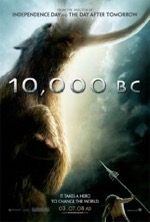10,000 BC (PG-13)

Starring: Camilla Belle
March 2008
“Woolly Wonka and the Raiders from Early Egypt”
When Roland Emmerich, director of such mega-blockbusters as Independence Day and The Day After Tomorrow, decided to do a historical adventure he really rolled back the calendar. Based on sketchy historical evidence, wild suppositions and mammoth-sized leaps of logic, 10,000 BC tells a simple, straightforward tale of courage, passion, rivalry and prophecy with dreadlocks and loincloths to boot.
The movie opens with a scene-setting narration by Omar Sharif, which introduces the main players—blue-eyed ingénue Evolet (Camilla Belle) and brash hunter D’Leh (Steven Strait), childhood friends turned adult lovers—their mountaintop village and their plight; shrinking mammoth populations threaten to bring on starvation and the much feared “last hunt.” The story heats up when the four-legged demons (proto-Egyptian slavers) raid the camp and carry off Evolet and many other villagers. Tribal elder Tic’Tic (Cliff Curtis), D’Leh, and two other tribesmen embark on a harrowing rescue mission—complete with narrow escapes, chance encounters and the occasional evisceration by a prehistoric ostrich—in order to retrieve their friends and loved ones.
With 10,000 BC, Emmerich and co-writer Harald Kloser have found the secret to being predictable without being boring. Of course, love him or hate him, boring is not a word generally associated with Emmerich or his films. Besides breathtaking cinematography (shot in South Africa, New Zealand, Thailand and Namibia) of snowcapped mountain ranges, sweltering jungles, tall grasslands and gorgeous desert vistas that would make director David Lean (Lawrence of Arabia) drool, the movie’s effects-laden action sequences are undoubtedly the movie’s cornerstone. Let’s face it, without the action scenes the movie, with its no-name cast, alternate-history lesson, contrived storyline and monosyllabic dialogue, wouldn’t have amounted to very much.
It’s reported (Empire/March, 08) that the animal animation took two effects houses two years to complete. At one point, when rendering estimates exceeded the time remaining until the movie’s premier, Emmerich made the executive decision to reduce mammoth fur density by 50 percent. Despite this CG shearing, the mammoths look surprisingly respectable, mostly because their movements resemble present day pachyderms. The same cannot be said of the saber-toothed tigers which are embarrassingly fake-looking, both in appearance and movement. As far as feral felines are concerned, the film’s saber-toothed cats represent a significant regression from Narnia’s lion, Aslan, which had its own CG challenges. Fortunately, the ancient tigers only appear in a few scenes, and soon enough we’re back to watching the not-so-woolly mammoths stampeding down pyramid ramps, knocking off anyone or anything that gets in their way like massive, prehistoric bowling balls.
For all of its historical inaccuracies and screenplay shortcomings, 10,000 BC is a visual spectacle, pure and simple. Proudly showcasing breathtaking backgrounds, Emmerich gets it right when he uses real locations instead of CG ones (Lucas’ prequels suffered from the reverse). There’s something uniquely organic and exotic in Emmerich’s use of various locales in the film; each landscape—tundra, tropical, desert, etc.—serves to characterize the different climates while providing color, texture, atmosphere and, dare I say it, artistry.
Emmerich’s unbound imagination and unbridled vision have forged 10,000 BC into a unique viewing experience. However, when a sequel is excavated, let’s hope the writers find some semblance of a storyline for 9,990 BC. With any luck, that’s also the year the saber-toothed tiger became extinct.
Rating: 2